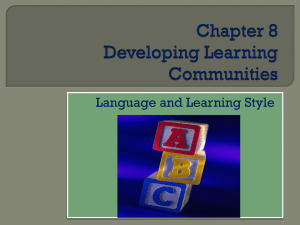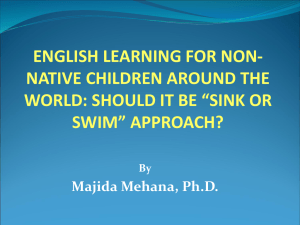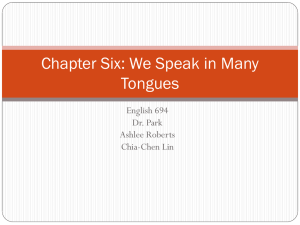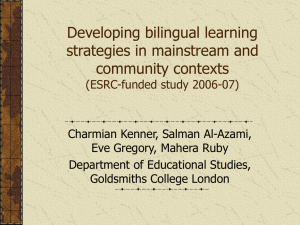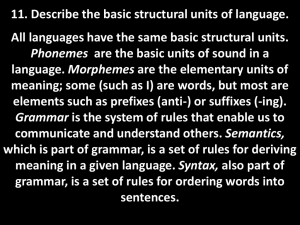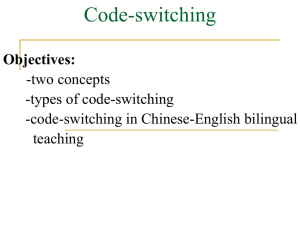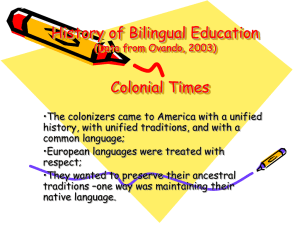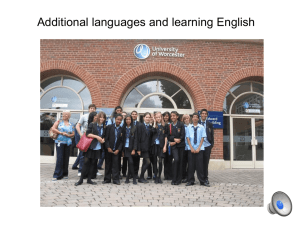Whither Official English? Implications of Census Data
advertisement
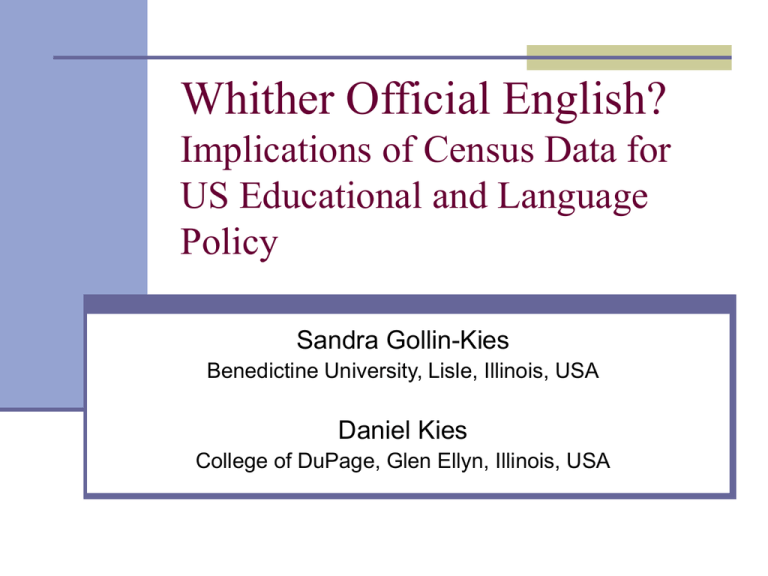
Whither Official English? Implications of Census Data for US Educational and Language Policy Sandra Gollin-Kies Benedictine University, Lisle, Illinois, USA Daniel Kies College of DuPage, Glen Ellyn, Illinois, USA Summary We analyze US Census and other survey data from 1980 to 2012. We critically analyze “Official English” and “English only” discourse in the popular media. We refute claims made by English protectionists that bilingualism leads to a fractured society, wastes taxpayers’ money, and encourages hordes of “others” who cannot or will not communicate with the wider populations. Media Discourse: English Only Lou Dobbs, CNN Discusses “English Only” in US schools with the superintendent of Arizona’s public schools https://www.youtube.com/watch?v=7Ii0n4aewuE Issues framed by politics of fear and ignorance (1/3): Poli-economic stress Confounding illegal immigration and language issues Fear of the “other” “Border security outrage”; Fear of “Illegals” bringing crime and disease, taking Americans’ jobs, wasting taxpayers’ money on education. Federal vs state control vs control by “the people” Fear of a federal “aristocracy”; federal judges; Support for states rights; smaller government Ignorance of what bilingual education means Voters misinformed: “I eliminated it”; children learning English “faster” through immersion; Economic issues English is “the language of success”; “parents want their children to speak English.” Issues framed by politics of fear and ignorance (2/3): pic = 1000 words Confounding illegal immigration and language issues Fear of the “other” “Border security outrage”; Fear of “Illegals” bringing crime and disease, taking Americans’ jobs, wasting taxpayers’ money on education. Federal vs state control vs control by “the people” Fear of a federal “aristocracy”; federal judges; Support for states rights; smaller government Ignorance of what bilingual education means Voters misinformed: “I eliminated it”; children learning English “faster” through immersion; Economic issues English is “the language of success”; “parents want their children to speak English.” Issues framed by politics of fear and ignorance (3/3): “Language decay” Some argue in the pop media/cultural arena that contact with foreign languages will lead to the decay, decline, corruption, or death of English. First point of evidence – population. Are the numbers of English speakers in decline? English is still growing as a first language and as the most demanded second language in the US & the world. Second point of evidence – restricted use. One could rightly argue that a language is in decline if its uses are restricted. For example, if a language's uses were to be restricted to just one mode of discourse (speech or writing), or to be restricted to informal uses (or formal uses) only, or to be deemed unacceptable in educational or governmental settings, etc., or to lack special vocabularies needed for certain functions (medicine, for example), then one could argue that a language is in decline, moving perhaps toward language death. Media Discourse: Official English WLWT: States that have Official English policies, discussion of assimilation and language adoption between generations https://www.youtube.com/watch?v=cHVRDay8UEk Demolishing assumptions Most immigrants want children to learn English, but given an informed choice, also want bilingual education (Wiley and Wright, 2004). Most immigrants receive education in English only, or at best, “weak” bilingual programs (Menken and Kleyn, 2010) Majority of immigrants lose native language and exclusively use English by 3rd generation (Fishman,1991). Overwhelming evidence that bilingualism is beneficial, linguistically, academically, socially, and possibly cognitively (e.g., Cummins 2000). Issues of politics, race, economics 2001 Patriot Act - heightened xenophobia 2007 onwards: economic insecurity fuels community fears of immigrants taking jobs. Opposition to Obama’s Dream Act - children of illegal immigrants’ path to citizenship Media beat-up of illegals crossing border (57,000 children since Oct 2013) Bilingual education is electoral poison for both major parties. A brief recent history of restrictive language policies English Only, English as an official language; anti-bilingual education. 1960s- late 90s. Bilingual education increasingly accepted. 1981 Cal. Sen Hayakawa’s constitutional amendment proposal for English as an official language. 1998. Calif Prop. 227 mandated English only instruction with waivers for bilingual education only if requested by parents; shortage of bilingual teachers and ESL certified teachers. Similar legislation passed in Arizona, Massachusetts, Colorado. Moves to make English the official language 2006 amendments to Immigration Bill 2611 (Tardy, 2009). Sen. Inhofe (R): Amendment 4064 - make English the national language (emphasized entitlement) Sen. Salazar (D): Amendment 4073 - English as the “common unifying language” (emphasized civil rights) (Both amendments passed Senate, but not enacted into law.) by 2011, 27 states had English Only laws, 9 more in progress. US Census Data 1980-2010 US Census taken every decade For further information on foreign-born population, see: www.census.gov/population/www/socdemo/foreign/index.html American Community Survey (ACS) Nationwide survey samples 3.5 mill addresses and includes housing units and group quarters (e.g. prisons and nursing facilities). For details on sampling accuracy see: www.census.gov/acs/www/Downloads/data_documentation/ Accuracy/ACS_Accuracy_of_Data_2012.pdf> Lang. spoken at home and selfreported English speaking ability Home Lang. 1980 % 2011 % All speakers age 210,247,455 100% 5+ 291,524,091 100% English only 187,187,415 89% 230,947,071 79% Lang. other than English (LOE) 23,060,040 11% 60,577,020 Speaks Eng. “Very well” 12,879,004 55.85% 35,255,826 of LOE 58.2% of LOE Speaks Eng. “with some difficulty”* 10,181,036 44.15% 25,321,194 of LOE 41.8% of LOE 81 mill.+ Increase 21% *Includes all who report speaking English less than very well. Figures calculated from US Census Bureau Data: 1980, 2013, 2014. Self-reported proficiency of foreignborn who speak English* Speaks Eng. 1980 2011 “Very well” 56% 58% “well” 26% 19.4% “not well” 13% 15.4% “not at all” 5% 7.0% “with some difficulty”* 44% 42% * Aggregate numbers rounded Figure reproduced from Gambino, Acosta and Grieco, 2014 Figure reproduced from Gambino, Acosta and Grieco, 2014 Figure reproduced from Ryan, 2013 Figure reproduced from Gambino, Acosta and Grieco, 2014 Figure reproduced from Gambino, Acosta and Grieco, 2014 NCLB encourages English-only “immersion” No Child Left Behind* 2001- G.W.Bush reauthorized the Elementary and Secondary Education Act. Title VII (Bilingual Education Act) replaced by Lang instruction for LEP and immigrant students. NCLB allocates funds for indigenous lang maintenance, but not for bilingual education. Emphasizes transition to English; dual immersion only if enough native English speakers want to learn the other language. Accountability: NCLB mandates that all children meet grade level expectations. Annual Yearly Progress (AYP) aims for 100% proficiency, without exceptions for ELLs except that they do not have to take the test in their first year of instruction. But schools under pressure to demonstrate participation, so many schools test all the children using high stakes tests in English regardless of background. *Wiley and Wright, 2004 Educational implications of Englishonly policies Cambodians in California Cambodian students in English-only schools with teachers not certified to teach ELLs had weaker primary language skills and lacked mastery of English. Reported communication difficulties at home, work and college, and self-identity issues. Hispanics in New York (Wright, 2004) (Menken & Kleyn, 2010). 1/3 of all ELLS in New York secondary schools are long-term (LTELLS). Prior schooling (7+ yrs) has been bilingually subtractive. Students enter high school with limited academic literacy in English (in spite of oral bilingualism). Negative effects on studies in all subject areas. Effects of bilingual education Lopez and McEneaney (2012) ELL students in Arizona (with weakest bilingual emphasis) on av. scored 13,5 points lower (more than 1 yr below) reading comp. expected for fourth grade, compared with states with stronger bilingual programs (e.g., TX, NM). Stronger emphasis on bilingual education had a positive effect on both ELL and non-ELL Hispanic fourth graders’ reading ability. No evidence that recent (English only) reforms in California or Arizona have positively affected reading achievement in Hispanic students. Conclusions US public opinion and language policy Conflates bilingualism with language “ghettos” Driven by xenophobia in public arena Driven by expediency in the political arena Bilingual programs lack funding Cultural loss Educational loss Economic loss What’s needed Restore funding for bilingual education More accessible public information/education on benefits of bilingual education and bilingual citizenry More teacher training (beyond mere prof. devt. for cultural diversity) for bilingual education Use bilinguals as a resource for teaching in a globalized world References Cummins, J. (2000). Language power and pedagogy: Bilingual children in the crossfire. Clevedon, UK: Multilingual Matters. Fishman, J. (1991) Reversing language shift. Clevedon, UK. Multilingual Matters. Gambino, C.P., Costa, Y.D., & Grieco, C.M. (2014). Englishspeaking ability of the foreign-born population of the United States: 2012. American Community Survey Reports ACS-26. US Census Bureau, Washington DC. Lopez, F. & McEneaney, E. (2012). State implementation of language acquisition policies and reading achievement among Hispanic students. Educational Policy. 16 (3) 418-464. Menken, K. & Kleyn, T. (2010). The long-term impact of subtractive schooling in the educational experiences of secondary English language learners. International Journal of Bilingual Education and Bilingualism. 13 (4) 399-417. References contd. Quentin-Dixon, L., Zhao, J., Shin, J.Y., Wu, S., Su, J.H., Burgess-Brigham, R., Gezar, M.U., & Snow, C. (2012). What we know about second language acquisition: A synthesis of four perceptions. Review of Educational Research. 82 (1) 5-60. Ryan C. (2013).Language use in the United States: 2011. American Community Survey Reports ACS-22. US Census Bureau, Washington DC. Tardy, C. (2009). “Press 1 for English”: textual and ideological networks in a newspaper debate on US language policy. Discourse and Society. (20). 265-286. Wiley, T.G. & Wright, W.E. (2004). Against the undertow: Language- minority education policy and politics in the “age of accountability.” Educational Policy. 18 (1)142-168. Wright, W. (2004). What English-only really means: A study of the implementation of California language policy with Cambodian American students. International Journal of Bilingual Education and Bilingualism. 7 (1) 1-23. Thank You! Sandra Gollin-Kies, PhD Associate Professor, Dept. of Languages and Literature Benedictine University, Lisle, Illinois, USA skies@ben.edu Daniel Kies, PhD Professor, Dept. of English College of DuPage, Glen Ellyn, Illinois, USA kiesdan@cod.edu Website: www.rhetory.com Appendix: additional material Next two videos represent politicians’ and the public’s views of English nationally and globally. Media Discourse: English Only Political Comments Rick Santorum Newt Gingrich Santorum discusses Puerto Rican statehood and the necessity for all states to use English as requirement for statehood. Gingrich discusses Spanish, “the language of the ghetto.” https://www.youtube.com/watch?v=7B0yKIL7moo Media Discourse: Official English popular opinion Homeland - Your Voice - Should English Be the Official Language? An informal survey https://www.youtube.com/watch?v=kJDHjB2VI78
